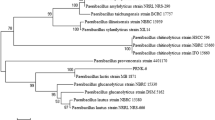Summary
The degradation of fluoranthene by pure cultures of Alcaligenes denitrificanss WW1, isolated from contaminated soil samples, was investigated. The strain showed maximum degradation rates of 0.3 mg fluoranthene/ml per day. A denitrificans was able to utilize also naphthalene, 1- and 2-methylnaphthalene, phenanthrene, and anthracene as sole carbon sources and to co-metabolize fuuorence, pyrene, and benzo(a)anthracene. During growth on fluoranthene in batch culture two metabolic products that were completely degraded before growth entered the stationary phase were detected in the culture fluid. Anslyses by UV, mass and NMR spectroscopy identified the products as acenaphthenone and 3-hydroxymethyl-4,5-benzocoumarine. Fluoranthene-grown resting cells of A. denitrificans showed degradative activity towards 2,3-dihydroxybenzoic acid, pyrogallol, salicylic acid, and catechol. The enzymatic activities in extracts of fluoranthene-induced cells indicate a meta ring fission involved in the degradation of fluoranthene. From these data new aspects of the biodegradative pathway of fluoranthene have been predicted.
Similar content being viewed by others
References
Baeyer A, Villiger B (1899) Einwirkungen des Caro'schen Reagens auf Ketone. Ber Dtsch Chem 32:3625–3633
Barnsley EA (1975) Bacterial degradation of fluoranthene and benzo(a)pyrene. Can J Microbiol 21:1004–1008
Barnsley EA (1976) Naphthalene metabolism of Pseudomonas: the oxidation of 1,2-dihydroxynaphthalene to 2-hydroxychromene-2-carboxylic acid and the formation of 2-hydroxybenzalpyruvate. Biochem Biophys Res Commun 72:1116–1121
Bradford MM (1976) A rapid and sensitive method for the quantification of microgram quantities of protein utilizing the principle of protein-dye binding. Anal Biochem 72:248–254
Bumpus JA (1989) Biodegradation of polycyclic aromatic hydrocarbons by Phanerochaete chrysosporium. Appl Environ Microbiol 55:154–158
Callahan MA, Slimak MW, Gabel NW, May IP, Fowler CF, Freed JR, Jennings P, Durfee RC, Whitmore FC, Maestri B, Mabey WR, Holt BR, Gould C (1979) Water related environmental fate of 129 priory pollutants. Vol. II: Halogenated aliphatic hydrocarbons, halogenated ethers, monocyclic aromatics, phthalate esters, polycylic aromatic hydrocarbons, nitrosoamines and miscellaneous compounds. EPA-440/4-79-029 b
Cerniglia CE (1984) Microbial metabolism of polycyclic aromatic hydrocarbons. Adv Appl Microbiol 30:31–71
Chapman PJ, Meerman G, Gunsalus IC, Srinivasan R, Rinehart KL (1966) A new acyclic acid metabolite in camphor oxidation. J Am Chem Soc 88:618–619
Conrad HE, DuBus R, Gunsalus IC (1961) An enzyme system for cyclic ketone lactonization. Biochem Biophys Res Commun 6:293–297
Donoghue NA, Norris DB, Trudgill PW (1976) The purification and properties of cyclohexanone oxygenase from Nocardia globerula CL1 and Acinetobacter NCIB 9871. Eur J Biochem 63:175–192
Evans WC, Fernley HN, Griffiths E (1965) Oxidative metabolism of phenanthrene and anthracene by soil pseudomonads. Biochem J 95:819–831
Fieser LF, Cason J (1940) O-Halide synthesis of 10-methyl-1',9-methylene-1, 2-benzanthracene. J Am Chem Soc 62:432–436
Fujisawa H (1970) Protocatechuate 3,4-dioxygenase (pseudomonads). Methods Enzymol 17A:526–529
Gibson TD (1984) Microbial degradation of organic compounds. Dekker, New York
Heitkamp MA, Franklin W, Cerniglia CE (1988a) Microbial metabolism of polycyclic aromatic hydrocarbons: isolation and characterization of a pyrene-degrading bacterium. Appl Environ Microbiol 54:2549–2555
Heitkamp MA, Freeman JP, Miller DW, Cerniglia CE (1988b) Pyrene degradation by a Mycobacterium sp.: isolation and identification of ring oxidation and ring fission products. Appl Environ Microbiol 54:2556–2565
Kingsbury GC, Sims RC, Whie JB (1979) Multimedia goals for environmental assessment. EPA-600/7-79-176 b
Laflamme RE, Hite RA (1978) The global distribution of polycyclic aromatic hydrocarbons in recent sediments. Geochim Cosmochim Acta 42:289–303
Mahaffey WR, Gibson DT, Cerniglia CE (1988) Bacterial oxidation of chemical carcinogens: formation of polycyclic aromatic acids from benz(a)anthracene. Appl Environ Microbiol 54:2415–2423
Müller JG, Chapman PJ, Blattmann BO, Pritchard PH (1990) Isolation and characterization of a fluoranthene-utilizing strain of Pseudomonas paucimobilis. Appl Environ Microbiol 56:1079–1086
Nakazawa T, Nakazawa A (1970) Pyrocatechase (pseudomonads). Methods Enzymol 17A:518–522
Nozaki M (1970) Metapyrocatechase (pseudomonads). Methods Enzymol 17A:522–525
Nozaki M, Kotani S, Ono K, Senoh S (1970) Metapytocatechase III. Substrate specificity and mode of ring fission. Biochem Biophys Acta 220:213–223
Pahlmann R, Pelkonen O (1987) Mutagenicity studies of different polycyclic aromatic hydrocarbons: the significans of enzymatic factors and molecular structures. Carcinogenesis 8:773–778
Pfennig N, Lippert KD (1966) Über das Vitamin-B-12-Bedürfnis phototropher Schwefelbakterien. Arch Microbiol 55:245–256
Poh CL, Bayly RC (1980) Evidence for isofunctional enzymes used in m-cresol and 2,5-xylenol degradation via the gentisate pathway of Pseudomonas alcaligenes. J Bacteriol 143:59–69
Saeki Y, Nozaki M, Senoh S (1980) Cleavage of pyrogallol by nonheme iron-containing dioxygenases. J Biol Chem 255:8465–8471
Schocken MJ, Gibson DT (1984) Bacterial oxidation of the polycyclic aromatic hydrocarbons acenaphthene and acenapthylene. Appl Environ Microbiol 48:10–16
Weissenfels WD, Beyer M, Klein J (1989) Bakterieller Abbau von Phenanthren, Fluoren und Fluoranthen. Forum Mikrobiol 1–2: 104
Weissenfels WD, Beyer M, Klein J (1990) Degradation of phenanthrene, fluorene, and fluoranthene by pure bacterial cultures. Appl Microbiol Biotechnol 32:479–484
White KL (1986) An overview of immunotoxicology and carcinogenic polycyclic aromatic hydrocarbons. Environ Carcinog Rev C4:163–202
Author information
Authors and Affiliations
Rights and permissions
About this article
Cite this article
Weissenfels, W.D., Beyer, M., Klein, J. et al. Microbial metabolism of fluoranthene: isolation and identification of ring fission products. Appl Microbiol Biotechnol 34, 528–535 (1991). https://doi.org/10.1007/BF00180583
Received:
Accepted:
Issue Date:
DOI: https://doi.org/10.1007/BF00180583




